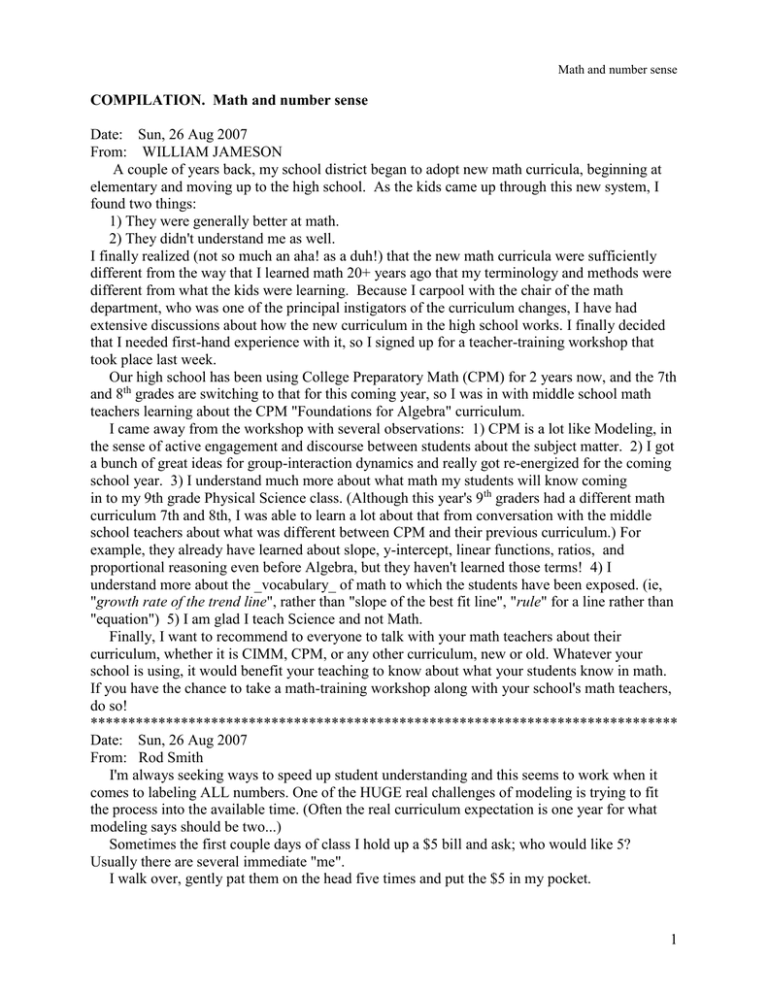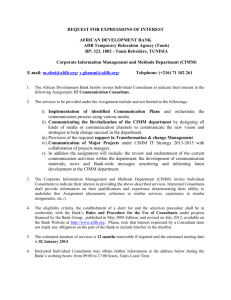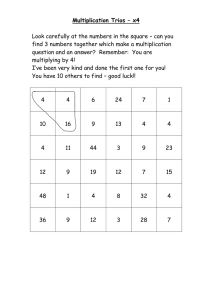Date: Sun, 26 Aug 2007
advertisement

Math and number sense COMPILATION. Math and number sense Date: Sun, 26 Aug 2007 From: WILLIAM JAMESON A couple of years back, my school district began to adopt new math curricula, beginning at elementary and moving up to the high school. As the kids came up through this new system, I found two things: 1) They were generally better at math. 2) They didn't understand me as well. I finally realized (not so much an aha! as a duh!) that the new math curricula were sufficiently different from the way that I learned math 20+ years ago that my terminology and methods were different from what the kids were learning. Because I carpool with the chair of the math department, who was one of the principal instigators of the curriculum changes, I have had extensive discussions about how the new curriculum in the high school works. I finally decided that I needed first-hand experience with it, so I signed up for a teacher-training workshop that took place last week. Our high school has been using College Preparatory Math (CPM) for 2 years now, and the 7th and 8th grades are switching to that for this coming year, so I was in with middle school math teachers learning about the CPM "Foundations for Algebra" curriculum. I came away from the workshop with several observations: 1) CPM is a lot like Modeling, in the sense of active engagement and discourse between students about the subject matter. 2) I got a bunch of great ideas for group-interaction dynamics and really got re-energized for the coming school year. 3) I understand much more about what math my students will know coming in to my 9th grade Physical Science class. (Although this year's 9th graders had a different math curriculum 7th and 8th, I was able to learn a lot about that from conversation with the middle school teachers about what was different between CPM and their previous curriculum.) For example, they already have learned about slope, y-intercept, linear functions, ratios, and proportional reasoning even before Algebra, but they haven't learned those terms! 4) I understand more about the _vocabulary_ of math to which the students have been exposed. (ie, "growth rate of the trend line", rather than "slope of the best fit line", "rule" for a line rather than "equation") 5) I am glad I teach Science and not Math. Finally, I want to recommend to everyone to talk with your math teachers about their curriculum, whether it is CIMM, CPM, or any other curriculum, new or old. Whatever your school is using, it would benefit your teaching to know about what your students know in math. If you have the chance to take a math-training workshop along with your school's math teachers, do so! ****************************************************************************** Date: Sun, 26 Aug 2007 From: Rod Smith I'm always seeking ways to speed up student understanding and this seems to work when it comes to labeling ALL numbers. One of the HUGE real challenges of modeling is trying to fit the process into the available time. (Often the real curriculum expectation is one year for what modeling says should be two...) Sometimes the first couple days of class I hold up a $5 bill and ask; who would like 5? Usually there are several immediate "me". I walk over, gently pat them on the head five times and put the $5 in my pocket. 1 Math and number sense Then I ask if anyone would like 25. Usually there is a slow taker -- I give them a quarter. How about 1? I have a pipette which I then fill with water and drop one drop on someone's head. Or 3 -- I give them 3 pieces of paper... By this time I ask what this MEANS... Unanimously they will say; always label numbers! To which I say: numbers REALLY don't mean anything without a label. Then I ask if there can be numbers without labels. I usually get a long pause and a tentative "yes". So I ask; what does... 3 ... mean? Almost always I get a long silence. To which I ask, what does 6 divided by 2 mean? Slow unsure response: 3. So 3 is a really a division problem where the labels cancel? This usually takes 10 minutes depending on the class and seems to really speed up understanding these important concepts... Naturally I must provide repetition and consistency in my requirements for students... ****************************************************************************** Date: Tue, 4 Sep 2007 A forwarded message from Dr. Rob MacDuff, developer of Cognitive Instruction in Math Modeling (CIMM) I have been following the proceedings with great interest on what does 6/2 +2=? mean. The struggles to make sense of this remind me of the struggles I went through. My biggest problem was always the math that I had been taught (more about this later). We have all been taught, rightly or wrongly, that first we start off with numerals as a list of ordered symbols. Next numerals act as labels for a variety of context-based situations. Then as time goes on the context-based situations become generalized to form our concept of number, and that process we call abstraction. Number has some of the properties of quantities; by that I mean we can add them (1 + 1= 2; more on this later) and the answer corresponds to what would happen if quantities were added. The difficulty is how do we multiply them (3 apples x 2 apples = ?); and the answer is well, 3x2 is just a shorthand for multiple addition. In other words the 3 does not have apples as a referent but 2 does. (This is very different in CIMM as both 3 and 2 have the same type of reference: relationships; and multiplication is not multiple addition in any sense). Since division is the inverse of multiplication, then division must be multiple subtraction, except if the number is negative then it is multiple addition. (Division and multiplication take on very different meanings in CIMM). Number has become a reified entity with its own properties. The symbol 2 has a referent of twoness or the count of a quantity where the unit is tacit. A whole host of supporting language has developed around this particular conception of number. CIMM shifts the idea that referent of a numeral is an abstraction of quantity (i.e. an entity) to numerals as symbols for part/whole relationships and only part/whole relationships and not whether both parts have a common unit. When you make this shift then everything shifts with it. Suppose you take 6 dots and separate them (I am avoiding the word division for the moment) into groups. Now there are a number of things I might like to know about this new situation. How many groups? How many dots in each group? How many dots are in some fraction of the whole? Each question has a different unit or units, and so what operations can we use to construct the appropriate answer: multiplication? division? What is new in CIMM are the following: the group and dot are both valid units; there are product and quotient relationships (products and quotients are not inverses); there are multiple types of division and multiplication; quantities can be added but not relationships, except under 2 Math and number sense special circumstances; addition of numbers (relationships) becomes a theorem not an axiom; orders of operations only become necessary if you want to have machines do calculations. There are many more but this is enough to give a sense of the types of changes necessary to fully understand CIMM. The beauty is that EVERY symbol has a specific referent. A whole host of supporting language has developed around this conception of number: fraction, equivalence, identity, relationship, conceptual system, representational system, product, multiplication, division, quotient, etc. All these terms now have taken on a different meaning. What I see happening is the attempt to utilize the language of standard mathematics to CIMM. e.g., "goes into": 2 goes into 6 three times, so 6 divided by 2 equals 3. Does 2 dots go into 6 dots 3 times? If it does, then 3 what? e.g., "times": 2 (3) means 2 times 3. Does 2d mean 2 times a dot? If you think it makes sense, are you thinking of 2 as a relationship? This list is endless. I mentioned above that my biggest problem was the math that I had been taught. What I mean by that was my struggle to keep various mathematical ideas, only to finally realize that they had to be discarded. In learning mathematics there are three stages that everyone must go through. Stage one: numerals as labels; stage two: numerals as symbols for abstractions of quantity; and stage three: numerals as representations of relationships. The question is, is there any advantage in switching to CIMM? Here is an example of student (remedial class) responses on the idea of slope. Visualize a T-table and graph. Teacher, pointing to x values: where are these on the graph? Students: the horizontal line. Teacher, pointing to y values: where are these on the graph? Students: the vertical line. Teacher: If x-values are here, the y-values are there, then what is this line in the T-table? Half dozen hands go up: the relationship between the x and y values. These students see a straight line as representing a situation where the relationship is constant. The slope is just a measure of the relationship. [Editor's note: an introduction to CIMM is at http://modeling.asu.edu] 3



